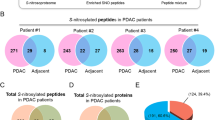Abstract
The tumor suppressor PTEN (phosphatase and tensin homolog deleted on chromosome 10) is not only a protein, but also a lipid phosphatase that can negatively regulate the serine/threonine kinase Akt. It has been reported that PTEN can be regulated by means of phosphorylation. However, whether PTEN can be regulated by another post-translational protein modification (S-nitrosylation) was not fully elucidated. In this study, we investigated the S-nitrosylation of PTEN during transient cerebral ischemia/reperfusion in rat hippocampus. Transient brain ischemia was induced by the four-vessel occlusion in Sprague–Dawley rats. Our data show that S-nitrosylation of PTEN was increased significantly after 12 h of reperfusion compared with sham control. Pretreatment with the inhibitor of nNOS (7-NI) and the inhibitor of iNOS could inhibit PTEN’s activity and decrease S-nitrosylation of PTEN. Taken together, these results indicate that nitric oxide could regulate PTEN’s activity via S-nitrosylation during transient global ischemia in rat hippocampus.




Similar content being viewed by others
References
Oudit GY, Sun H, Kerfant BG et al (2004) The role of phosphoinositide-3 kinase and PTEN in cardiovascular physiology and disease. J Mol Cell Cardiol 37:449–471. doi:10.1016/j.yjmcc.2004.05.015
Stambolic V, Suzuki A, de la Pompa JL et al (1998) Negative regulation of PKB/Akt-dependent cell survival by the tumor suppressor PTEN. Cell 95:29–39. doi:10.1016/S0092-8674(00)81780-8
Seo JH, Ahn Y, Lee SR et al (2005) The major target of the endogenously generated reactive oxygen species in response to insulin stimulation is phosphatase and tensin homolog and not phosphoinositide-3 kinase (PI-3 kinase) in the PI-3 kinase/Akt pathway. Mol Biol Cell 16:348–357. doi:10.1091/mbc.E04-05-0369
Patel L, Pass I, Coxon P et al (2001) Tumor suppressor and anti-inflammatory actions of PPARgamma agonists are mediated via upregulation of PTEN. Curr Biol 11:764–768. doi:10.1016/S0960-9822(01)00225-1
Virolle T, Adamson ED, Baron V et al (2001) The Egr-1 transcription factor directly activates PTEN during irradiation-induced signaling. Nat Cell Biol 3:1124–1128. doi:10.1038/ncb1201-1124
Lee SR, Yang KS, Kwon J et al (2002) Reversible inactivation of the tumor suppressor PTEN by H2O2. J Biol Chem 277:20336–20342. doi:10.1074/jbc.M111899200
Leslie NR, Bennett D, Lindsay YE et al (2003) Redox regulation of PI 3-kinase signalling via inactivation of PTEN. EMBO J 22:5501–5510. doi:10.1093/emboj/cdg513
Stamler JS, Hausladen A (1998) Oxidative modifications in nitrosative stress. Nat Struct Biol 5:247–249. doi:10.1038/nsb0498-247
Stamler JS, Simon DI, Osborne JA et al (1992) S-nitrosylation of proteins with nitric oxide: synthesis and characterization of biologically active compounds. Proc Natl Acad Sci USA 89:444–448. doi:10.1073/pnas.89.1.444
Pulsinelli WA, Brierley JB (1979) A new model of bilateral hemispheric ischemia in the unanesthetized rat. Stroke 10:267–272
Jaffrey SR, Erdjument-Bromage H, Ferris CD et al (2001) Protein S-nitrosylation: a physiological signal for neuronal nitric oxide. Nat Cell Biol 3:193–197. doi:10.1038/35055104
Cai Z, Semenza GL (2005) PTEN activity is modulated during ischemia and reperfusion: involvement in the induction and decay of preconditioning. Circ Res 97:1351–1359. doi:10.1161/01.RES.0000195656.52760.30
Lu Y, Yu Q, Liu JH et al (2003) Src family protein–tyrosine kinases alter the function of PTEN to regulate phosphatidylionsitol 3-kinase/AKT cascades. J Biom Chem 278:40057–40066
Myers MP, Stolarov JP, Eng C et al (1997) P-TEN, the tumor suppressor from human chromosome10q23, is a dual-specificity phosphatases. Proc Natl Acad Sci USA 94:9052–9057. doi:10.1073/pnas.94.17.9052
Mayer B, Pfeiffer S, Schrammel A et al (1998) A new pathway of nitric oxide/cyclic GMP signaling involving S-nitrosoglutathione. J Biol Chem 273:3264–3270. doi:10.1074/jbc.273.6.3264
Choi YB, Tenneti L, Le DA et al (2000) Molecular basis of NMDA receptor-coupled ion channel modulation by S-nitrosylation. Nat Neurosci 3:15–21. doi:10.1038/71090
Mannick JB, Hausladen A, Liu L et al (1999) Fas-induced caspase denitrosylation. Science 284:651–654. doi:10.1126/science.284.5414.651
Hui L, Pei DS, Zhang QG et al (2005) The neuroprotection of insulin on ischemic brain injury in rat hippocampus through negative regulation of JNK signaling pathway by PI3K/Akt activation. Brain Res 1052:1–9. doi:10.1016/j.brainres.2005.05.043
Wu DN, Pei DS, Wang Q et al (2006) Down-regulation of PTEN by sodium orthovanadate inhibits ASK1 activation via PI3-K/Akt during cerebral ischemia in rat hippocampus. Neurosci Lett 404:98–102. doi:10.1016/j.neulet.2006.05.018
Zhang QG, Wu DN, Han D et al (2007) Critical role of PTEN in the coupling between PI3K/Akt and JNK1/2 signaling in ischemic brain injury. FEBS Lett 581:495–505. doi:10.1016/j.febslet.2006.12.055
Leslie NR, Downes CP (2004) PTEN function: how normal cells control it and tumour cells lose it. Biochem J 382:1–11. doi:10.1042/BJ20040825
Acknowledgments
This article was supported by a grant from the Project of the National Natural Science Foundation of China (No. 30800309). President Special Grant of Xuzhou Medical College 08KJZ02 and Natural Science Research Funds of Jiangsu Province (No. BK2006035 and BK2006536).
Author information
Authors and Affiliations
Corresponding author
Additional information
The authors D.-S. Pei, Y.-F. Sun contribute equally to this work.
Rights and permissions
About this article
Cite this article
Pei, DS., Sun, YF. & Song, YJ. S-nitrosylation of PTEN Invovled in Ischemic Brain Injury in Rat Hippocampal CA1 Region. Neurochem Res 34, 1507–1512 (2009). https://doi.org/10.1007/s11064-009-9938-3
Received:
Accepted:
Published:
Issue Date:
DOI: https://doi.org/10.1007/s11064-009-9938-3




